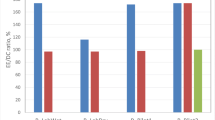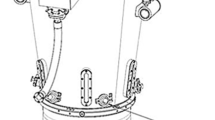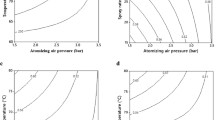Abstract
Continuous twin screw wet granulation (TSWG) systems are possible pathways for oral solid dosage manufacturing in the pharmaceutical industry. TSWG requires a drying step after granulation before the tableting process. Typically, semi-continuous fluidized bed dryers (FBDs) are used for this purpose. At the same time, the pharmaceutical sector is interested in mathematical prediction models to save resources during the early drug product development (DPD) stage or to control manufacturing. Several authors have already developed prediction models for semi-continuous drying processes. However, these model structures reported systematic prediction offsets, which could be related to the incomplete implementation of fluidization and granule segregation phenomena. This study evaluates the complex fluidization behavior of wet granules in industrially relevant semi-continuous FBDs. A transparent perspex version of the dryer was used for the analysis of bed height, pressure drop, porosity, segregation, and spatial heating patterns at varying process settings. The investigated behaviors of the fluidizing bed will be helpful to derive phenomenological (sub)models for the detailed description of segregation in the semi-continuous fluidized bed system. In this study, it was found that semi-continuous FBDs are characterized by a change in fluidization regime from plug flow to a bubbling bed at the moment that the granule bed slumps. Secondly, the presence of size-based vertical segregation phenomena as well as spatial temperature differences were proven. The experimental results suggest that larger granules are dried under more intense drying conditions than smaller granules.








Similar content being viewed by others
Abbreviations
- Abbr.:
-
Description
- API :
-
active pharmaceutical ingredient
- C1 :
-
ConsiGma™-1
- C25 :
-
ConsiGma™-25
- CQA :
-
critical quality attribute
- DPD :
-
drug product development
- FBD :
-
fluidized bed dryer
- GSD :
-
granule size distribution
- LS :
-
liquid-to-solid
- MFR :
-
mass flow rate
- QbD :
-
quality by design
- TSWG :
-
twin-screw wet granulation
References
Stauffer F, Boulanger E, Pilcer G. Sampling and diversion strategy for twin-screw granulation lines using batch statistical process monitoring. European J Pharma Sci. 2022;171:106126.
Aaltonen J, Kogermann K, Strachan CJ, Rantanen J. In-line monitoring of solid-state transitions during fluidisation. Chem Eng Sci. 2007;62(1):408–15. https://doi.org/10.1016/j.ces.2006.08.061.
Lee SL, O’Connor TF, Yang X, Cruz CN, Chatterjee S, Madurawe RD, et al. Modernizing pharmaceutical manufacturing: from batch to continuous production. J Pharma Innov. 2015;10(3):191–9.
Vandeputte T, Ghijs M, Van Hauwermeiren D, Dos Santos Schultz E, Schäfer E, Fanny S, et al. Mechanistic modeling of semicontinuous fluidized bed drying of pharmaceutical granules by incorporating single particle and bulk drying kinetics. In J Pharma 2023;:123447. https://doi.org/10.1016/j.ijpharm.2023.123447.
Wormsbecker M, Adams A, Pugsley T, Winters C. Segregation by size difference in a conical fluidized bed of pharmaceutical granulate. Powder Technol. 2005;153(1):72–80.
Khanna P, Pugsley T, Tanfara H, Dumont H. Radioactive particle tracking in a lab-scale conical fluidized bed dryer containing pharmaceutical granule. Canadian J Chem Eng. 2008;86(3):563–70.
Dahl S, Hrenya C. Size segregation in gas–solid fluidized beds with continuous size distributions. Chem Eng Sci. 2005;60(23):6658–73.
Luthra K, Sadaka S. Investigation of rough rice drying in fixed and fluidized bed dryers utilizing dehumidified air as a drying agent. Drying Technol. 2021;39(8):1059–73.
Anantharaman A, Cocco RA, Chew JW. Evaluation of correlations for minimum fluidization velocity in gas-solid fluidization. Powder Technol. 2018;323:454–85.
Davidson JF, Harrison D. Fluidised particles. Cambridge University Press; 1963.
Kunii D, Levenspiel O. Fluidization engineering. Butterworth-Heinemann; 1991.
Gunn D. Transfer of heat or mass to particles in fixed and fluidised beds. Int J Heat Mass Transfer. 1978;21(4):467–76. https://doi.org/10.1016/0017-9310(78)90080-7.
Ganzha V, Upadhyay S, Saxena S. A mechanistic theory for heat transfer between fluidized beds of large particles and immersed surfaces. Int J Heat Mass Transfer. 1982;25(10):1531–40. https://doi.org/10.1016/0017-9310(82)90032-1.
Zhou ZY, Yu AB, Zulli P. Particle scale study of heat transfer in packed and bubbling fluidized beds. AIChE Journal. 2009;55(4):868–84. https://doi.org/10.1002/aic.11823.
Zhou Z, Yu A, Zulli P. A new computational method for studying heat transfer in fluid bed reactors. Powder Technol. 2010;197(1):102–10. https://doi.org/10.1016/j.powtec.2009.09.002.
Basu P, Nag P. An investigation into heat transfer in circulating fluidized beds. Int J Heat Mass Transfer. 1987;30(11):2399–409.
Van Heerden C, Nobel A, Van Krevelen D. Mechanism of heat transfer in fluidized beds. Ind Eng Chem. 1953;45(6):1237–42.
Borodulya V, Epanov YG, Ganzha V, Tephtskii YS. Heat transfer in fluidized beds. J Eng Phys Thermophysics. 1986;49(4):621–6.
Valenzuela J, Glicksman L. An experimental study of solids mixing in a freely bubbling two-dimensional fluidized bed. Powder Technol. 1984;38(1):63–72. https://doi.org/10.1016/0032-5910(84)80034-0.
Tsuji T, Miyauchi T, Oh S, Tanaka T. Simultaneous measurement of particle motion and temperature in two-dimensional fluidized bed with heat transfer. KONA Powder Particle J. 2010;28:167–79. https://doi.org/10.14356/kona.2010015.
Patil AV, Peters E, Sutkar VS, Deen N, Kuipers J. A study of heat transfer in fluidized beds using an integrated dia/piv/ir technique. Chem Eng J. 2015;259:90–106.
Lakio S, Heinämäki J, Yliruusi J. Colorful drying. AAPS PharmSciTech. 2010;11:46–53. https://doi.org/10.1208/s12249-009-9351-x.
Chiba S, Chiba T, Nienow A, Kobayashi H. The minimum fluidisation velocity, bed expansion and pressure-drop profile of binary particle mixtures. Powder Technol. 1979;22(2):255–69. https://doi.org/10.1016/0032-5910(79)80031-5.
Hui Wang Z, Chen G. Heat and mass transfer in batch fluidized-bed drying of porous particles. Chem Eng Sci. 2000;55(10):1857–69. https://doi.org/10.1016/S0009-2509(99)00446-7.
Gauthier D, Zerguerras S, Flamant G. Influence of the particle size distribution of powders on the velocities of minimum and complete fluidization. Chem Eng J. 1999;74(3):181–96.
Wang Y, Cheng Y, Jin Y, Bi HT. On impacts of solid properties and operating conditions on the performance of gas-solid fluidization systems. Powder Technol. 2006;172(3):167–76.
Mortier S, De Beer T, Gernaey K, Vercruysse J, Fonteyne M, Remon JP, et al. Mechanistic modelling of the drying behaviour of single pharmaceutical granules. European J Pharma Biopharmaceutics. 2012;80(3):682–9.
Ghijs M, Schäfer E, Kumar A, Cappuyns P, Van Assche I, De Leersnyder F, et al. Modeling of semicontinuous fluid bed drying of pharmaceutical granules with respect to granule size. J Pharma Sci. 2019;108(6):2094–101.
Funding
This work was supported by Ghent University.
Author information
Authors and Affiliations
Contributions
T. Vandeputte: Conceptualization, Methodology, Software, Investigation, Validation, Visualization, Writing - original draft M. Ghijs: Conceptualization, Methodology, Software, Investigation, Validation, Writing - review & editing I. Nopens: Conceptualization, Methodology, Software, Writing - review & editing, Project administration T. De Beer: Conceptualization, Methodology, Investigation, Validation,Writing - review & editing, Project administration. All authors have read and agreed to the published version of the manuscript.
Corresponding author
Ethics declarations
Conflict of Interest
The authors declare that they have no known competing financial interests or personal relationships that could have appeared to influence the work reported in this paper.
Additional information
Publisher's Note
Springer Nature remains neutral with regard to jurisdictional claims in published maps and institutional affiliations.
Rights and permissions
Springer Nature or its licensor (e.g. a society or other partner) holds exclusive rights to this article under a publishing agreement with the author(s) or other rightsholder(s); author self-archiving of the accepted manuscript version of this article is solely governed by the terms of such publishing agreement and applicable law.
About this article
Cite this article
Vandeputte, T., Ghijs, M., Nopens, I. et al. A Colourful Way to Unravel the Important Fluidization-Related Granule Size Effect on Semi-Continuous Drying. AAPS PharmSciTech 25, 11 (2024). https://doi.org/10.1208/s12249-023-02711-8
Received:
Accepted:
Published:
DOI: https://doi.org/10.1208/s12249-023-02711-8




